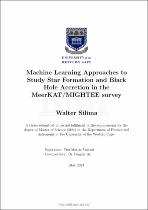| dc.contributor.advisor | Vaccari, Mattia | |
| dc.contributor.author | Silima, Walter | |
| dc.date.accessioned | 2023-07-24T09:43:17Z | |
| dc.date.available | 2023-07-24T09:43:17Z | |
| dc.date.issued | 2023 | |
| dc.identifier.uri | http://hdl.handle.net/11394/10406 | |
| dc.description | >Magister Scientiae - MSc | en_US |
| dc.description.abstract | Galaxy formation and evolution are driven by two main physical processes: star formation and black hole accretion. Both processes can be traced via the synchrotron emission at radio wavelengths. However, a reliable classification of radio sources as star-formation-dominated sources (or Star-Forming Galaxies, SFGs) and blackhole- accretion-dominated sources (or Active Galactic Nuclei, AGN) is non-trivial and often requires extensive use of multi-wavelength data. Although significant effort has been put into classifying radio sources as SFGs or AGN over the decades, the rapid growth of radio data available from facilities such as the South African MeerKAT telescope, the Australian Square Kilometre Array Pathfinder (ASKAP), and eventually the Square Kilometre Array (SKA) requires the development of efficient and reliable automated classification techniques. | en_US |
| dc.language.iso | en | en_US |
| dc.publisher | University of the Western Cape | en_US |
| dc.subject | Star-Forming Galaxies | en_US |
| dc.subject | Active Galactic Nuclei | en_US |
| dc.subject | Australian Square Kilometre Array Pathfinder | en_US |
| dc.subject | Galaxy formation | en_US |
| dc.subject | Machine Learning | en_US |
| dc.title | Machine learning approaches to study star formation and black hole accretion in the Meerkat/MIGHTEE survey | en_US |
| dc.rights.holder | University of the Western Cape | en_US |

